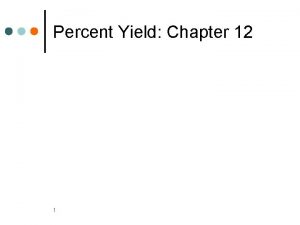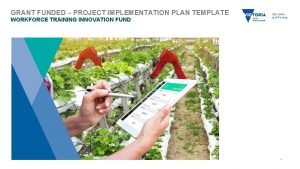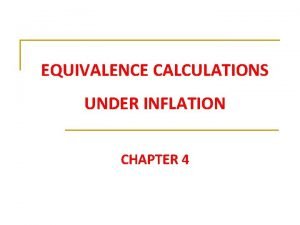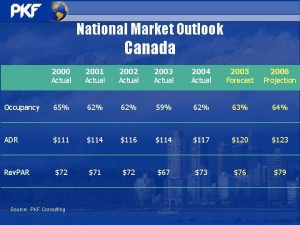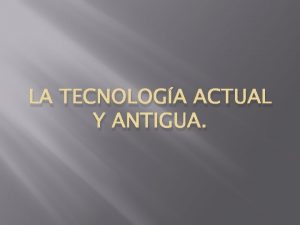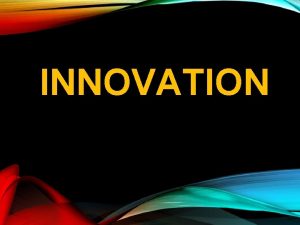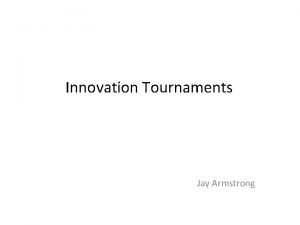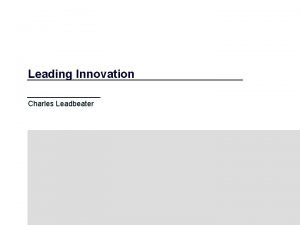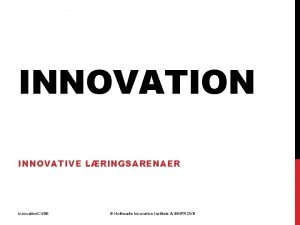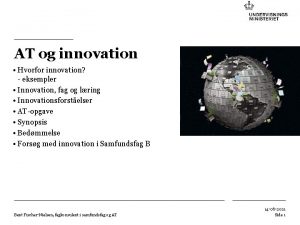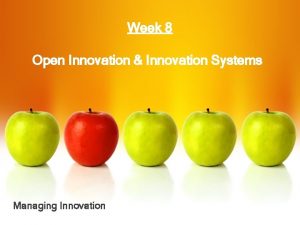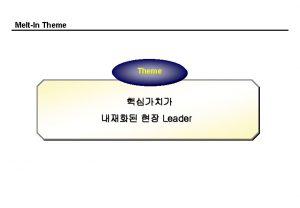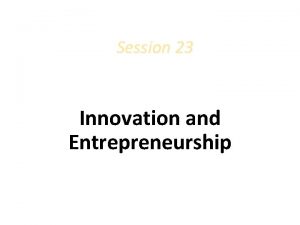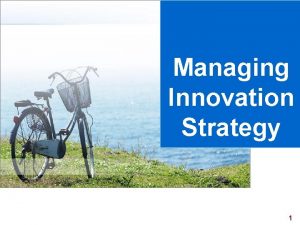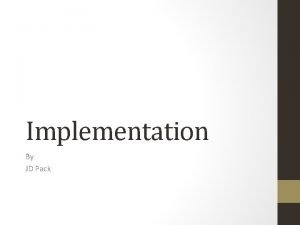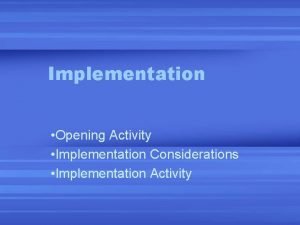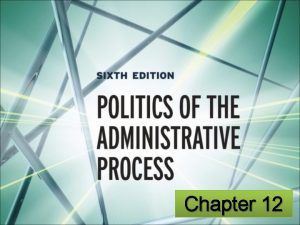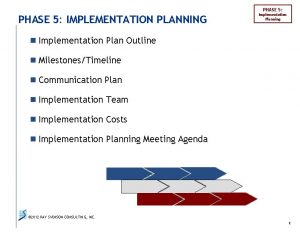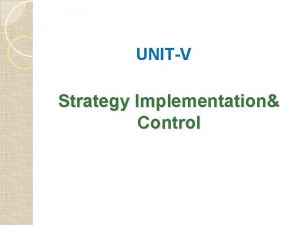Implementation Is the actual use of an innovation

























- Slides: 25

Implementation Is the actual use of an innovation or what an innovation consists of in practice. ~ Michael Fullan, Alan Pomfret

Implementation Became a major educational concern around 1970, when scholars began to highlight that the innovations of the 60’s had one fatal flaw—the ideas were not finding their way into the classroom! Goodlad & Klein’s study, Behind the Classroom Door Million$ of dollars were being spent on curriculum innovations and not being implemented.

Implementation Did you know? 90% of new curriculum fails to be implemented (Wiles & Bondi) Why? Seymour Sarason claimed that much educational reform has failed because those in charge of the efforts had little or a distorted understanding of the culture of schools.

Implementation 2 Valuable Ideas on practice of implementation 1. Distinction between fidelity & mutual expectation Fidelity- innovation being implemented faithfully as intended by developers Mutual adaptation- users adapt or alter the innovation to meet their own needs 2. An understanding that implementation is multi-dimensional (consisting of materials, behaviors, and beliefs)

Implementation 2 Phases Phase I 1995 -1997 - focuses on the innovation itself (no link to stud. Achievement) Phase II 1997 - Present- focused on how curriculum change can be seen as a part of system reform. (focuses more on stud. Achievement)

PLANNING FOR CURRICULUM Careful planning focuses on 3 factors: 1. People 2. Programs 3. Process

PLANNING FOR CURRICULUM 3 Ways to Persuade for a new curriculum: 1. It could bring some reward 2. Negative consequences of inaction 3. Ways it is similar to the ones already in place

PLANNING FOR CURRICULUM 1. Incrementalism 2. Communication 3. Support

PLANNING FOR CURRICULUM Types of Support Characteristics of Professional Support

VALUE & ROLE OF CHANGE Implementation should also be considered as a process of change. Change needs to have purpose, not just political expediency. Questions to consider : What happens when change occurs? What is the value & role of change? What is the source of change? Are all the consequences of change beneficial? Can educators control changes that affect them? Do different educators engage in change for the same reasons? Do schools that make major changes actually become the most innovative and effective? Is change synonymous with improvement?

VALUE & ROLE of CHANGE Activity: Stand up if you agree with the following statement…. . EDUCATORS TODAY ARE MORE EXPERT IN MANAGING CHANGE THAN IN DETERMINING THE VALUES & BENEFITS OF CHANGE DESIRED & ACCOMPLISHED

VALUE & ROLE of CHANGE Activity: Stand up if you agree with the following statement…. . MORE PEOPLE SEEM TO MANAGE CHANGE JUST TO BE IN COMPLIANCE WITH STATE AND FEDERAL DEMANDS THAN TO ENACT CURRICULAR CHANGE THAT WILL ACTUALLY INCREASE THE QUALITY OF INDIVIDUAL & SOCIAL LIFE FOR THE BENEFIT OF ALL.

VALUE & ROLE of CHANGE Activity: Stand up if you agree with the following statement…. . EVEN WITH OUR VALUES IN PLACE REGARDING EDUCATIONAL CHANGE, WE CANNOT PREDICT, EVEN WITH LIMITED PRECISION, HOW SUCCESSFUL THE CHANGE ACTIVITIES WILL BE FOR THOSE INVOLVED (THE TEACHERS) AND THOSE WHO EXPERIENCE THE CHANGED CURRICULUM (THE STUDENTS)

VALUE & ROLE of CHANGE • PUZZLE ACTIVITY

VALUE & ROLE OF CHANGE 5 Guidelines for Change 1. Innovations designed to increase student achievement 2. Successful innovations require change in the structure of a traditional school 3. Must be manageable & feasible for the average teacher 4. Successful change efforts must be organic rather than bureaucratic. (adaptive vs. strict rules) 5. Avoid the “do something, anything” mode

VALUE & ROLE OF CHANGE 2 Ways to Change • 1. Slow • 2. Rapid 3 Types of Change • 1. Planned • 2. Coercion • 3. Interaction • (4. Random)

RESISTANCE TO CHANGE Factors of Resisting Change 1. Inertia (the lack of desire to change) 2. Status Quo (people are satisfied with what they already have in place) 3. Rapidity of Change (always the next new thing) 4. Teacher’s lack of research knowledge (lack of time to read) 5. No financial or time support

RESISTANCE TO CHANGE Thomas Harvey’s List on Change Resistance 1. Lack of ownership 2. Lack of benefits 3. Increased burdens 4. Lack of administrative support 5. Loneliness 6. Insecurity 7. Norm incongruence 8. Boredom 9. Chaos 10. Differential knowledge 11. Sudden wholesale of change 12. Unique points of resistance

CHANGE AS A PROCESS Factors to Consider • The “lifeworld” • The key players involved • Teacher’s roles (‘see’ through different identities) Stages of Change 1. Initiation- sets the stages, gets the school receptive 2. Implementation- presenting the innovation & getting people to try it out 3. Maintenance- monitoring of innovation

MODELS OF CHANGE ORC-Overcoming Resistance to Change *Rests on the assumption that the success or failure of planned organizational change basically depends on leaders’ ability to overcome staff resistance to change Guidelines for this model: a. Address peoples’ fears & doubts b. Takes their values & perspectives into account c. Gives school administrators & teachers equal power- involved in discussions and decisions Stages for this model: 1. Unrelated Concerns- no relationship between myself & the suggested change 2. Personal Concerns- How will this change affect me? 3. Task-Related Concerns- How do I implement it? How much time will it require? Materials? 4. Impact-Related Concerns- How will it impact my students? KEY PLAYERS: Administrators, Directors, Teachers, Supervisors

MODELS OF CHANGE OD-Organizational Development Model *Emphasis is on teamwork & organizational culture (Schmuck & Miles~ post-modern ideas) 7 Characteristics of this model: (French & Bell) 1. Emphasis on teamwork for addressing issues 2. Emphasis on group and intergroup processes 3. Use of action research 4. Collaboration within the organization 5. Organization’s culture must be considered 6. Those in charge serve as consultants & facilitators 7. Appreciation of organization’s dynamics in a continuously changing environment. KEY PLAYERS: Administrators, Directors, Supervisors

MODELS OF CHANGE CBA-Concerns-Based Adoption *Based on the belief that all change originates with individuals. (Individuals change, and through their changed behaviors, institutions change. ) *This model addresses only the adoption (implementation) of curriculum, not development and design. THE FOCUS IS ON ENABLING TEACHERS TO ADOPT THE CURRICULUM & TO VIEW IT AS THEIR OWN. *Stages for this model: 1. Awareness of innovation 2. Awareness of informational level 3. Concern for self 4. Concern for teaching 5. Concern for students *In this model, curriculum is not implemented until teachers’ concerns have been adequately addressed. Teachers are expected to be creative with it and modify where necessary, tailoring it to their students. KEY PLAYERS: Teachers

MODELS OF CHANGE SYSTEMS Model *This model is based on the idea that the school is an organization of loosely coupled units: departments, classrooms, and individuals. These parts have flexible relationships. The belief is that most schools have little centralized control, especially over what occurs in the classroom. For this reason, it is difficult for curricular change to be implemented as an edict from central office Wisdom for Promoting Change within this model: 1. Progress from certainty to ambiguity 2. Allow for some chaos in your order 3. Look beyond the person to the behavior 4. Realize that people who feel victimized resist change 5. Use your fallibility to build your credibility 6. Be sensitive 7. Upgrade permanent to temporary 8. Have humor KEY PLAYERS: Administrators, Directors, Teachers, Supervisors

EDUCATIONAL CHANGE MODEL: (Michael Fullan) FACTORS AFFECTING CHANGE 1. Characteristics of the change 2. Characteristics at the school-district level 3. Characteristics at the school level 4. Characteristics external to the local system KEY PLAYERS: Administrators, teachers, students, school board, community members, government

CONCLUSION Curriculum implementation is much more than handing out new materials for courses of study. It requires an understanding of the program’s purpose, the roles people will play, and those who are affected. The process must be planned, but not rigidly. It requires continued fine-tuning. It requires a community of trust.
 Actual yield
Actual yield Actual grace and sanctifying grace
Actual grace and sanctifying grace Mysite socccd
Mysite socccd Radical innovation vs disruptive innovation
Radical innovation vs disruptive innovation Grant implementation plan example
Grant implementation plan example Rate of inflation formula
Rate of inflation formula Hát kết hợp bộ gõ cơ thể
Hát kết hợp bộ gõ cơ thể Ng-html
Ng-html Bổ thể
Bổ thể Tỉ lệ cơ thể trẻ em
Tỉ lệ cơ thể trẻ em Voi kéo gỗ như thế nào
Voi kéo gỗ như thế nào Thang điểm glasgow
Thang điểm glasgow Chúa sống lại
Chúa sống lại Các môn thể thao bắt đầu bằng từ đua
Các môn thể thao bắt đầu bằng từ đua Thế nào là hệ số cao nhất
Thế nào là hệ số cao nhất Các châu lục và đại dương trên thế giới
Các châu lục và đại dương trên thế giới Công thức tính độ biến thiên đông lượng
Công thức tính độ biến thiên đông lượng Trời xanh đây là của chúng ta thể thơ
Trời xanh đây là của chúng ta thể thơ Cách giải mật thư tọa độ
Cách giải mật thư tọa độ 101012 bằng
101012 bằng Phản ứng thế ankan
Phản ứng thế ankan Các châu lục và đại dương trên thế giới
Các châu lục và đại dương trên thế giới Thơ thất ngôn tứ tuyệt đường luật
Thơ thất ngôn tứ tuyệt đường luật Quá trình desamine hóa có thể tạo ra
Quá trình desamine hóa có thể tạo ra Một số thể thơ truyền thống
Một số thể thơ truyền thống Cái miệng bé xinh thế chỉ nói điều hay thôi
Cái miệng bé xinh thế chỉ nói điều hay thôi
